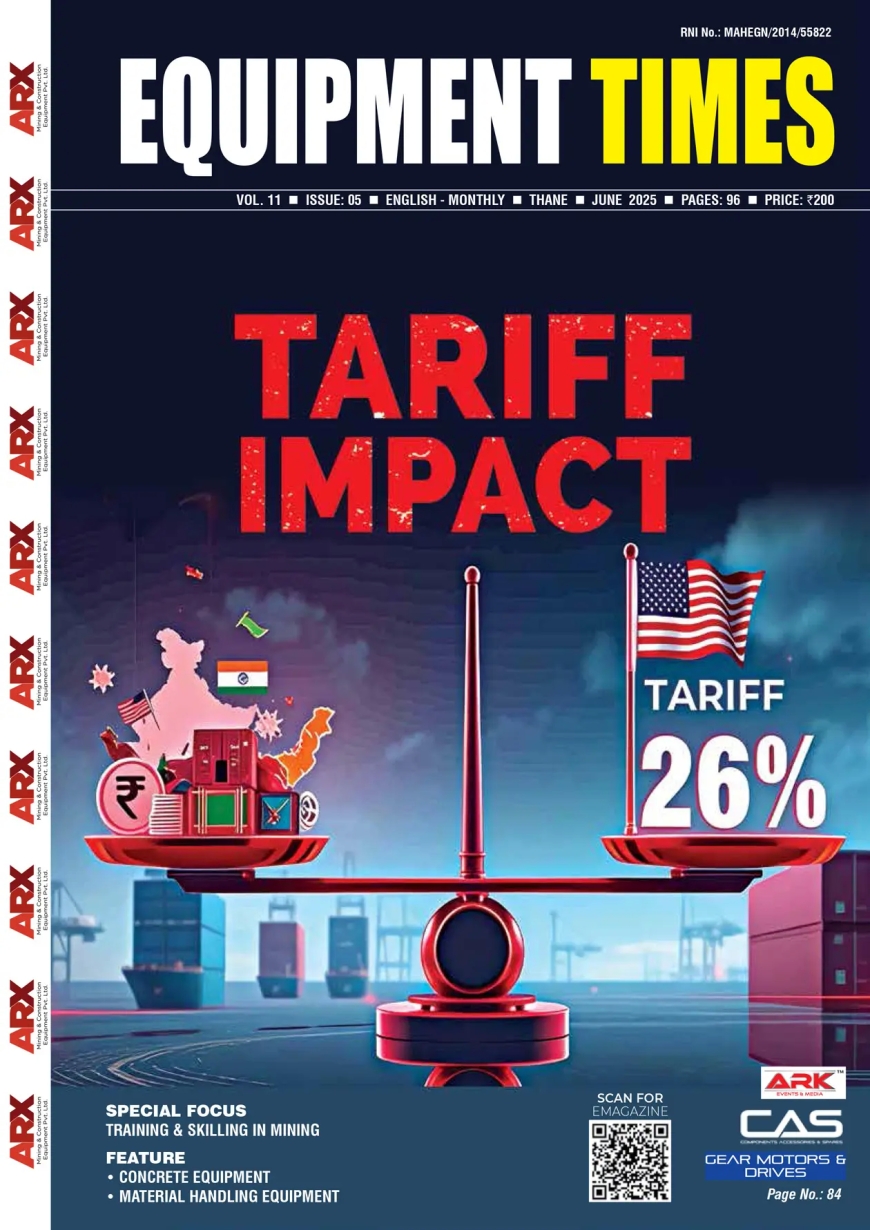India Construction Equipment Market: Current Status and Outlook
Ujjwal Parwal, Director and Founder of RationalStat Leading Global Market Research & Procurement Intelligence Firm The global construction equipment market is estimated at US$ 210 billion in 2023 and is expected to grow at a strong CAGR of more

The global construction equipment market is estimated at US$ 210 billion in 2023 and is expected to grow at a strong CAGR of more than 5% during the forecast period, driven by growing sales in China, India, and Latin American economies.
Urbanization and road construction activities undoubtedly play a major role in the overall picture of the Indian construction equipment market. Moreover, volatility in the real estate and construction equipment market has resulted in demand-supply gaps that hamper the growth of the sector and its trends.
Construction equipment sales in 2023 are estimated to drop to just over 1.11 million units and are expected to reach 1.05 million in 2024, 1.03 million in 2025, 1.07 million in 2026, and 1.12 million in 2027. India’s construction equipment market is estimated at 69,500 units in 2023 and expected to reach 86,730 units by the end of 2027, mainly driven by efforts to plug gaps in its infrastructure as it focuses on growing into a US$ 5 trillion economy. Importantly, it has been estimated that India is set to be the 3rd largest construction market in 2024. India’s construction equipment industry is likely to witness over US$ 4.5 billion worth of investments in the next 6-7 years, as demand arising out of infrastructure projects touches a new high.
The global construction equipment market is facing regulatory pressure to introduce electric and hybrid construction vehicles over conventional ones. Even though the cost of construction equipment and the heavy loans taken for the acquisition of the same still haunt most of the players in the construction market, renting and leasing of such equipment are slowly catching the eye of the market.
Market Overview
RationalStat believes the Indian construction equipment market is mainly driven by robust economic development, substantial infrastructure investments, growing OEM presence, higher FDIs in the construction sector, and growing imports. Despite the growth, there are some inherent challenges faced by the India construction equipment market. In India, the demand for construction equipment is more than the supply. Hence, most leading manufacturers have invested in India for manufacturing to meet this gap.
In terms of global market overview, the sales of the leading ten companies accounted for 68% of the global market share, mainly dominated by Caterpillar, Komatsu, XCMG, Sany Group, Zoomlion, and John Deere, among others.
Electrification of construction equipment is likely to remain a foremost trend in the coming 20 years, primarily supported by development in battery sizing, charging, vehicle power, pricing, and more. The electric construction machine market is in its early stages, poised to benefit from the precedents set by other sectors in electrification. Leveraging established supply chains for batteries, motors, and other electric vehicle components, it is well-positioned for swift acceleration.
| A technological revolution is on the horizon for the construction sector. The methods of creation and design are experiencing a significant transformation. Technologies like 3D printing, BIM, and AR are enabling us to improve efficiency, reduce errors, and enhance safety and transparency. The future looks promising as we progressively integrate and adopt these technological advancements, unlocking the full potential of the construction technology industry. |
Original Equipment Manufacturers (OEMs) are actively transitioning their product portfolios to embrace electrification, starting with mini-electric excavators and progressing to larger machines. This report examines OEM initiatives, policy incentives, and potential total cost of ownership savings, projecting a 10-year CAGR of 38%. Anticipating significant expansion, the electric construction machine market is forecasted to reach a value of approximately US$ 150 billion by 2043. This trajectory aligns with international carbon neutrality goals, positioning the construction industry to meet targets by 2050.
Segmental Analysis
- As the electric mini-excavator market establishes itself, Original Equipment Manufacturers (OEMs) are transitioning to larger machines. The focus is on electrifying large excavators with operating weights exceeding 6 tonnes and loaders of a similar size.
- Loaders and excavators collectively represent nearly 55% of construction vehicle sales by volume, with excavators being the predominant contributor both in terms of volume and revenue due to their larger size and correspondingly higher prices.
- Chinese OEMs, in particular, are displaying a keen interest in electrifying larger excavators and incorporating sizable batteries. One highlighted example in this report utilizes a 525kWh battery and employs double gun-DC charging to recharge this substantial battery in just 2 hours.
- Mini-excavators, the world’s third-largest segment by volume and the largest in Europe present a convenient entry point for the construction industry’s electrification journey due to their smaller size requiring reasonably sized batteries.
- In 2023, six of the top ten construction OEMs, including Caterpillar, Komatsu, Kubota, and Hitachi, either had a production electric mini-excavator or a concept/prototype. JCB and Volvo, with series production of electric mini-excavators, have played a pivotal role in initiating the electric mini-excavator market, driven both by emission reduction targets and market demand.
Emerging Technological Developments
The construction equipment sector is undergoing a rapid transformation due to the adoption of new technologies. These technologies are helping to improve efficiency, safety, and sustainability on construction sites.
Here are some of the most notable new technology developments in the construction equipment sector:
- Artificial intelligence (AI) and machine learning (ML)are being used to develop autonomous and semi-autonomous construction equipment. This equipment can perform tasks such as excavation, grading, and paving without the need for human operators. AI and ML are also being used to develop predictive maintenance systems that can help prevent equipment breakdowns.
- The Internet of Things (IoT)is being used to connect construction equipment to the internet. This allows for real-time data collection and analysis, which can be used to improve equipment utilization, track materials, and monitor safety.
- Dronesare being used for a variety of tasks on construction sites, such as surveying, inspecting structures, and delivering materials. Drones can collect data that would be difficult or impossible to collect using traditional methods.
- Virtual reality (VR) and augmented reality (AR)are being used to train construction workers and to provide them with real-time information on construction sites. VR and AR can also be used to create virtual models of construction projects, which can help to improve coordination and communication among stakeholders.
Advances in India and Global Construction Equipment Market
The progress of digital and equipment technologies, the emergence of new products, and significant economic megatrends are collaboratively propelling machine control to the forefront of the construction industry.
- In December 2023, CASE Construction Equipment is set to showcase its cutting-edge machines at the 12th International Construction Equipment and Construction Technology Trade Fair – CII EXCON 2023. Notably, CASE will introduce six new products, marking its entry into two new categories in the domestic market.
- In September 2023, JC Bamford (JCB) Excavators planned to export 45% construction equipment machines it produces in India.
- In September 2023, China’s Xuzhou Construction Machinery Group (XCMG) aimed to triple its sales of battery- and hydrogen-powered heavy machines to 30% of the total revenue in the next four years, as state decarbonisation policies and lower operating costs drive adoption.
- In May 2023, Case Construction, a brand of CNH Industrial announced that it is ramping up its exports out of India as the new regulations. The company is investing US$ 40 million in a compact product line and skid steer facility in Pithampur, India.
- In March 2023, Volvo CE sold a hauler using fossil-free steel supplied by steelmaker SSAB.
- In March 2023, Komatsu launched a 20-ton PC210LCE electric excavator, the excavator has 451 kWh of battery capacity, for up to 8 hours of operating time.
- In February 2023, Volvo Construction Equipment (Volvo CE) announced an investment into battery pack production at its excavator plant in Changwon, South Korea, signaling once again its ambition to drive industry transformation with sustainable solutions.
- In January 2023, John Deere rolled out new battery-powered farming and construction equipment.
Market Trend Analysis
During the analysis, the market study suggests that the suppliers are strongly focusing on launching newer products with greater efficiencies and environment-friendly propulsion systems. Product launch is not the only trend witnessed by the Indian Construction Equipment market.
Transforming the Construction Equipment Sector: The Synergy of AI and Advanced Batteries in India & Globally
The construction equipment sector is undergoing a transformative phase globally, with the integration of artificial intelligence (AI) and advanced battery technologies. In India, as well as on a global scale, these advancements are shaping the future landscape of the construction industry. The use of AI in construction equipment enhances efficiency, precision, and automation, revolutionizing traditional practices. Battery technologies play a crucial role, particularly in electric construction equipment, contributing to sustainability goals and reducing environmental impact. India, recognizing the potential of these technologies, is actively embracing AI and advanced batteries in the construction sector, aligning with its commitment to sustainable development. In conclusion, the convergence of AI and battery technologies is steering the construction equipment sector towards a more intelligent, sustainable, and efficient future. India, along with the rest of the world, is at the forefront of this transformation, unlocking new possibilities and setting the stage for a dynamic and technologically advanced construction industry.
Hits: 37








